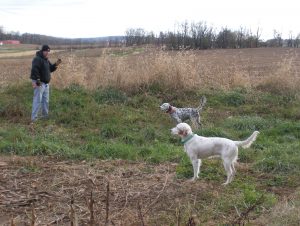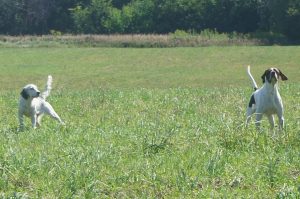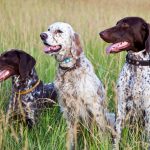Working Pointing Dogs Together
POINTING DOG POINTERS March 2016
By Bob and Jody Iler
You’re the proud owner of a pointing dog—and you know that one of the great pleasures in life is getting out there with your dog in the field, working together as a team as your pup hunts, finds and points birds! So, if this experience is so great, maybe it would be even better to get out there with two (or even more) pointing dogs! Right?
Hunting or working two pointing dogs together can be an enjoyable experience; it can also be a train wreck. Let’s talk about the advantages and benefits of working two dogs together as well as some of the pitfalls.
To simplify matters, let’s look at this issue as it applies to pups from the time they are small until they are completely trained, experienced pointing dogs. Young pups in a litter will learn all sorts of good things by rambling around with their brothers and sisters in a safe environment with low cover. This is the time to explore, play with each other, carry objects around, and perhaps even point a wing hanging from a fish pole—after all, if the rest of the gang is doing it, it must be fun!
During this period, and as time progresses, the pups will start showing their individual traits. Are they independent, setting off without a backward glance to see where you are? Is one pup more interested in following your lead? Is another more assertive, challenging his siblings? Maybe one agreeable fellow shows that he’s willing to take on the world as it comes, curious, playful and brave when he needs to be, but happy to spend a little time with you as well. During these early weeks, breeders also learn a lot about which pup would be good for a particular prospective owner. All of this together time is necessary for the pups’ development.
But once it’s time for the pup’s training to begin (translated: when you take your puppy home) we recommend developing your pup on his own. The different nature of different pups will dictate what type of “program” you’ll use for your particular pup; adding another pup to the mix at this stage would create unnecessary problems. Introducing your pup to field work and birds, teaching her to pay attention and “handle” for you, and acquainting her with the basics of yard work all entail one-on-one lessons, with you and your pup learning to be a team and focusing on one another with as few distractions as possible.
Fast forward to the stage where your pup is now what we call a “started dog.” She’s hunting with zest, handling fairly well for you, pointing or flash pointing birds, and developed to the gun. This is a good time to reintroduce another pup that is at the same level of development to the mix. This could mean that you have a friend who has a pup that is about the same age and ability level as your pup. It could mean (like us) that you have several pups at your home or kennel that have been developed separately and now would benefit from some occasional work with one another. Or it could mean that you’ve been bitten by the bug of field work and you’d like to enter your pup in some field events like an AKC junior hunt test.
Whether it’s with your friend and his pup in the field, working two of your pups together, or entering your pup in her first junior hunter test, you’ll notice that pups at this stage can often be more interested in each other at first than in anything else. If they’ve been developed well on birds and know that there are birds out in the field, the initial playful interaction with each other, chasing and running around, should dissipate as they begin to hunt. This is an important time for young dogs; working pups of this level together provides good socialization and practice for the future, when they’ll likely be hunting with another dog now and then. They learn that they are out there to hunt; they learn to be more independent and leave each other alone.
Often you’ll see inexperienced pups at hunt tests, chasing each other with joy and abandon as the frustrated owners try to separate the happy “kids.” This “tailgating” of pups with one another is natural and expected. If it continues and becomes a problem, then it’s back to the drawing board of training your pup alone to hunt for, find and chase birds, until that is the main objective fixated in his mind! Just like parents with unruly kids, it’s up to you to nip this tailgating problem in the bud, especially in field events, or you may risk being a bit unpopular, and it’s not helping your dog’s training.
During that first or second season, it’s important to bond with your hunting partner without other dogs in the field with you. This is the time for you to learn about your dog’s strong and weak areas and assess what needs to be improved. For example, maybe your dog is becoming a little deaf to your command to come. If you’ve added another dog to the mix, the chances of getting your own dog to pay attention to you are slim! His focus needs to be on working with and for you. Once your dog is hunting and handling reliably as your partner, you can feel confident in going out to enjoy a hunt with a friend and his dog.
Be careful, though, that the friend’s dog is at the same level of experience and training that your dog is at. Then the dogs will complement each other and make the hunt twice as much fun. You’ll cover more ground and find more birds with two dogs ranging out to hunt. The dogs will mean business and focus on finding the birds rather than each other, and should maintain good handling habits as well.
Range is another issue that is affected by hunting two dogs together. Perhaps your dog is a far reaching pointer and your buddy’s pointing dog works closer. This can be an advantage in finding birds, as less birds will be missed in that scenario. A far ranging dog can also increase the range of a dog that normally works closer. It may stir a little competitive streak in the closer dog and cause him to range out farther.
Some scenarios that can invite train wrecks in the field are working a young, inexperienced pup with an older dog; working a well-trained, finished dog with a started dog; and having too many dogs in the field.
In the first situation, the young pup won’t necessarily “learn” from his experienced companion. In fact, he may backtrack in his training if he finds himself in a situation he’s never been in and receives a scare, such as being spurred by a rooster pheasant, or having a gun shot over him when he’s not working a bird. And when you hunt a started dog with a finished one, the less experienced dog may steal a point or retrieve, or not back his well-trained companion that remains staunchly on point. This can cause problems for the dog that is steady to wing and shot, maintaining his manners while an upstart rushes in to steal the show. And in the last scenario, having more than two dogs hunting in the field can often translate into chaos, with the dogs ending up self-hunting, stealing points and retrieves, and perhaps even fighting.
It’s crucial to weigh both the advantages and disadvantages of hunting two dogs together before you actually do so. Keep in mind the age, training and experience of both dogs. Using common sense and the “less is better” philosophy should keep you out of trouble and help you to reap the rewards of working pointing dogs together!
Pointing Dog Pointers features monthly training tips by Bob and Jody Iler, who own Green Valley Kennels in Dubuque, Iowa. Bob and Jody have trained pointing dogs for over 35 years and have written many articles for The Pointing Dog Journal.







